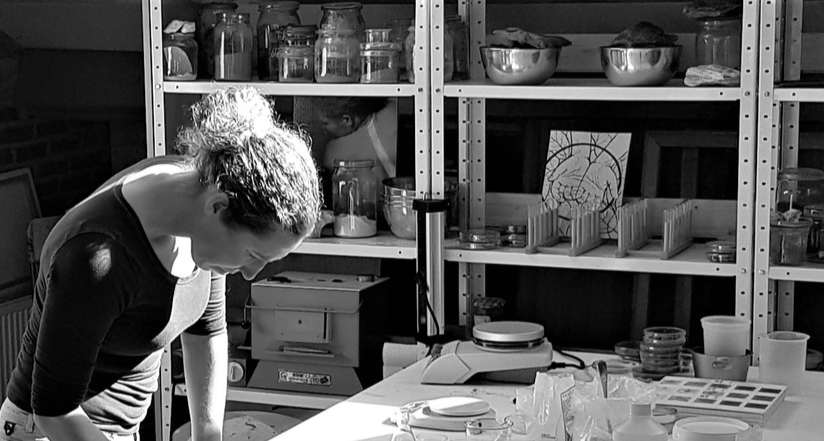
The Dutch Design Week in Eindhoven is the largest design festival in Northern Europe. Every year we pick nine designers that we think are this year’s hidden gems. You can read their stories here. Today: Dorieke Schreurs about sustainable paint.
What does an artist do at the Dutch Design Week? Researcher and visual artist Dorieke Schreurs explains why she is participating in the festival this year. For ten weeks she followed an intensive programme at BioArt Laboratories. At DDW you will see the results of her search for a bio-based and biodegradable alternative to acrylic paint.
She’s been following BioArt Lab from a distance for some time now, she says. The Eindhoven-based organisation of Jalila Essaïdi stimulates research in biomaterials and crossovers with other disciplines and invites talents from all over the world to develop their ideas here. Dorieke herself works mainly on the cutting edge of art, nature and science. Circularity is the central theme in her artistic practice.
In order to create a circular production process for herself, she immersed herself in old techniques such as tempera. A tried and tested method for making paint, but also laborious and time-consuming. Not something for the masses. She decides to submit a research proposal to the Talent Pressure Cooker of BioArt Lab to explore an alternative to acrylic paint that can be produced on a large scale. A bio-based and biodegradable paint for the creative sector.
In theory, she says, it should be possible, but it is not an easy job. The last months she studied chemical processes and called in the help of scientists. It is a search for the right composition of biopolymers and the best mixing orders. Her research is currently in full swing.

With her research she hopes to contribute to a more sustainable art sector. ‘The polymers that are still in paints today are actually petrochemical. If you clean your brush under the tap, liquid plastic particles and other harmful additives enter our water system.’ She continues: ‘A lot of research is already being done into sustainable alternatives to industrial paint, and I am curious to find an alternative within my own field of expertise. Acrylic colours are not only used in the creative sector by professional artists, but also by many hobby painters and school children. So I think you can have a big impact there with sustainable paint.’
In the world of design she sees that people are much more concerned with sustainability. Why is the art world lagging behind, when artists are often innovative and innovative? She lacks the link between art and social themes, art as a reflection of the time in which we live and the role of education in this, so that artists learn to think not only about the work of art, but also about the production process.
Then she answers the question she has just raised: ‘I have come to the conclusion for myself that it is easier to accept that a building or utensil is finite. That makes it easier to talk about sustainability and biodegradable materials. Finiteness is a much more difficult subject in art, especially for its maker.’ She emphasises that it is good to preserve art in such a way that it can still be hung in a museum for centuries to come, but honestly, most paintings will not end like this. ‘It is important to also make it possible for art to be biodegradable or renewable.’
Location: the work of Dorieke Schreurs and all other participants of the Talent Pressure Cooker will be on display at the new location of BioArt Laboratories, opposite the Philips Fruit Garden. The address is: Oirschotsedijk 14
The DDW Hidden Gems are published in collaboration with Dutch Design Daily and curator Katja Lucas of DDW. Would you like to visit the hidden gems yourself? Every day Brandstore Eindhoven/VVV organises a bike tour to the selected designers. For more info check the website or use this link to book a ticket.
Special offer for IO readers: the first 25 people receive a 10 euro discount on their ticket. Use the action code ‘Gems18’.


